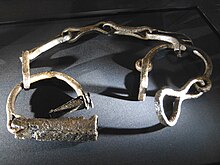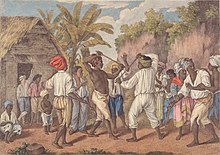This article is about the slave trade of medieval Ireland. For the system of unfree labour in return for passage across the Atlantic, see Irish indentured servants. For the transportation of convicts to other British colonies, see penal transportation. For the conflation of Irish slavery and African chattel slavery, see Irish slaves myth.

Slavery had already existed in Ireland for centuries by the time the Vikings began to establish their coastal settlements, but it was under the Norse-Gael Kingdom of Dublin that it reached its peak, in the 11th century.
History
Gaelic Ireland
See also: Slavery in medieval Europe
Early medieval legal texts provide a wealth of knowledge on the practice of slavery. Gaelic raiders kidnapped and enslaved people from across the Irish Sea for two centuries after the Fall of the Western Roman Empire destabilising Roman Britain; Saint Patrick was kidnapped by Gaelic raiders.
In the Brehon Laws, Senchus Mór and the Book of Acaill , a "daer fuidhir" ("servile inferior") was a name applied to all who did not belong to a clan, whether born in the clan territory or not. This was the lowest of the three classes of the non-free people. This class also was sub-divided into saer and daer, the daer fuidhirs being the class most closely resembling slaves. Even this lowest condition was not utterly hopeless; promotion was possible, and in constant operation. Therefore all families did not remain permanently in this kind of servitude but had the possibility of gradually rising from a lower to a higher degree according to a certain scale of progress, unless they committed some crime which would arrest that progress and cast them down again further. Slaves could be obtained through war, purchase and marriage to outsiders. The inheritability of slavery depends on the precise original relationship, while fuidher have been seen as a transitional status, after three generations serving the same lord, their children fell under the category senchléithe, akin to a semi hereditary serf status, while the law texts also provide details of downward mobility as well.
Viking period
See also: ThrallFrom the 9th to the 12th century Viking/Norse-Gael Dublin in particular was a major slave trading center which led to an increase in slavery. In 870, Vikings, most likely led by Olaf the White and Ivar the Boneless, besieged and captured the stronghold of Dumbarton Castle (Alt Clut), the capital of the Kingdom of Strathclyde in Scotland, and the next year took most of the site's inhabitants to the Dublin slave markets.
When the Vikings established early Scandinavian Dublin in 841, they began a slave market that would come to sell thralls captured both in Ireland and other countries as distant as Muslim Spain, as well as sending Irish slaves as far away as Iceland, where Gaels formed 40% of the founding population, and Anatolia. In 875, Irish slaves in Iceland launched Europe's largest slave rebellion since the end of the Roman Empire, when Hjörleifr Hróðmarsson's slaves killed him and fled to Vestmannaeyjar. Almost all recorded slave raids in this period took place in Leinster and southeast Ulster; while there was almost certainly similar activity in the south and west, only one raid from the Hebrides on the Aran Islands is recorded.
Slavery became more prevalent throughout Ireland the 11th century as port cities built up by Vikings flourished, with Dublin becoming the biggest slave market in Western Europe. Its main sources of supply were the Irish hinterland, Wales and Scotland. The Irish slave trade began to decline after William the Conqueror consolidated control of the English and Welsh coasts around 1080, and was dealt a severe blow when the Normans abolished slavery in 1102. The 1171 Council of Armagh freed all Englishmen and women who were enslaved in Ireland. It was clear from the Decree of the Council of Armagh that English were selling their children as slaves. "For the English people hitherto throughout the whole of their kingdom to the common injury of their people, had become accustomed to selling their sons and relatives in Ireland, to expose their children for sale as slaves, rather than suffer any need or want."
Barbary slave trade
See also: Barbary slave tradeBaltimore was depopulated in 1631 in the Sack of Baltimore, a raid by Barbary pirates from either Ottoman Algeria or Salé (Morocco). Between 100 and 237 people were abducted and sold into the Barbary slave trade, of whom only two or three ever saw Ireland again.
Atlantic slave trade
See also: RedlegAs was true for societies across Europe, Asia, & Africa during this time, there were individuals born in Ireland who became involved with the Atlantic slave trade between 1660 and 1815. Librarian Liam Hogan has described how Irish merchants profited from the trade, mostly indirectly as provisioners.
In more direct involvement for example, William Ronan worked for the Royal African Company and rose to become chairman of the committee of merchants at Cape Coast Castle on the Gold Coast (modern Ghana), running one of the world's largest slave markets between 1687 and 1697. Antoine Walsh, a Frenchman of Irish descent and prominent Jacobite based in Nantes, used his wealth generated from the slave trade to finance the Jacobite rising of 1745. Benjamin McMahon worked for eighteen years as an overseer on Jamaican plantations, later becoming an abolitionist and writing about his experiences. Tralee-born Irishman David Tuohy emigrated to Liverpool and became a captain on slave ships before settling down in the city to manage his business activities, which included the slave trade. Felix Doran (1708–1776) was an Irish Catholic, born in Ireland and moved to Liverpool where he became very wealthy from the slave trade, financing at least 69 slave voyages.

Several Caribbean Islands have significant Irish communities descended from indentured servants deported from Ireland by colonial British authorities following the 15th & 16th century Plantations of Ireland, with the like of Montserrat once hosting large Anglo-Irish owned and run sugar plantations that were dependent on slave labour.
Prominent US Civil Rights campaigner Jesse Jackson acknowledges his descent from “Scots-Irish” slave owners (i.e. colonial settlers from Britain who arrived in Ireland in the 17th century during the crown’s Plantation of Ulster) plantation owner, in South Carolina.
An Ulster-Scottish slave-owning great-great grandfather of US Senator Mitch McConnell also came to the US from Ireland. McConnell brought up this family history during the 2020 United States presidential election campaign to liken himself to Barack Obama.
The UCL Legacies of British Slavery database identifies the Irish Slave owners, compensated by the British Government, on abolition of legal slavery, in the British Empire.
Modern day
See also: Human trafficking in IrelandThe US Department of State criticised Ireland in 2018 for "not meeting the minimum standards for the elimination of trafficking"; types of modern slavery and forced labour include prostitution, trawler fishing and domestic service.
See also
References
- Dickson, David (2014). Dublin: The Making of a Capital City. Harvard University Press. p. 10. ISBN 9780674744448. Retrieved 2019-01-12.
- Medieval Ireland (2005): An Encyclopedia, Ed. Sean Duffy, 2017, Taylor & Francis, ISBN 1351666177, 9781351666176
- "Ginnell, Laurence, (1854–17 April 1923), MP N Westmeath, 1906–18, Westmeath Co., since 1918; Barrister, Middle Temple, 1893 and also of King's Inns, Dublin, 1906", Who Was Who, Oxford University Press, 2007-12-01, doi:10.1093/ww/9780199540884.013.u196920
- Rio, Alice (2017). Slavery After Rome, 500–1100. Oxford University Press.
- Eska, Charlene M (2011). "Women and Slavery in the Early Irish Laws". Studia Celtica Fennica. 8: 29–39.
- ^ The Historical encyclopedia of world slavery, Volume 1; Volume 7 By Junius P. Rodriguez ABC-CLIO, 1997
- Loveluck, C. (2013). Northwest Europe in the Early Middle Ages, C.AD 600–1150: A Comparative Archaeology. USA: Cambridge University Press. p. 321
- ^ "The Slave Market of Dublin". 23 April 2013.
- ^ "The Viking slave trade: entrepreneurs or heathen slavers?". 5 March 2013.
- "The Arctic Irish: fact or fiction?". 1 March 2013.
- "Medieval Irish merchants traded in slaves in Tunisia and Iceland". 2 August 2016.
- ^ "Archived copy" (PDF). static.sdu.dk. Archived from the original (PDF) on 18 January 2017. Retrieved 15 January 2022.
{{cite web}}: CS1 maint: archived copy as title (link) - Dickson, David (2014). Dublin The Making of a Capital City. Profile Books Ltd. p. 10. ISBN 978-0-674-74444-8.
- Rodgers, N. (31 January 2007). Ireland, Slavery and Anti-Slavery: 1612-1865. Springer. ISBN 9780230625228 – via Google Books.
- "Internet History Sourcebooks Project".
- "Internet History Sourcebooks Project". sourcebooks.fordham.edu. Retrieved 2020-01-27.
- ^ Ekin, Des (2008). The Stolen Village: Baltimore and the Barbary Pirates. Dublin: O'Brien Press.
- "When Britons Were Slaves in Africa". BBC History Magazine. BBC. January 2017. p. 66.
- "Salé et ses corsaires, 1666-1727: un port de course marocain au XVII". Leïla Maziane (in French). Rouen ; Caen: Publication Pôle Universitaire Normand: 173. 2007. ISBN 978-2-84133-282-3. Archived from the original on 25 September 2021. Retrieved 1 October 2020.
- O'Shea, Joe (28 October 2012). "Read Me: The Irish have not always been the victims of history". TheJournal.ie. Retrieved 2022-02-04.
- "Search | Legacies of British Slavery". www.ucl.ac.uk. Retrieved 2022-02-04.
- "Liam Hogan – Humanities Commons". Retrieved 2020-01-27.
- O'Shea, Joe (4 October 2012). Murder, Mutiny & Mayhem: The Blackest-Hearted Villains from Irish History. The O'Brien Press. ISBN 9781847175311 – via Google Books.
- "The Irish and the Atlantic slave trade". 28 February 2013.
- Higman, B. W. (March 20, 1995). Slave Population and Economy in Jamaica, 1807-1834. Press, University of the West Indies. ISBN 9789766400088 – via Google Books.
- "The Tuohy papers". British Online Archives.
- Richardson, David (2007). Liverpool and Transatlantic Slavery. UK: Liverpool University Press. ISBN 978-1-84631-066-9.
- Siggins, Lorna. "The Caribbean Irish: the other Emerald Isle". The Irish Times. Retrieved 2022-02-04.
- Bruns, Roger (2005). Jesse Jackson. Greenwood Publishing. ISBN 9780313331381.
- "McConnell likens himself to Obama: 'We both are the descendants of slave owners'". NBC News. 9 July 2019. Retrieved 4 February 2022.
- "Maps | Legacies of British Slavery". www.ucl.ac.uk. Retrieved 2022-02-04.
- Pollak, Sorcha. "State criticised by US over inaction on modern slavery". The Irish Times.
- Hennessy, Michelle (5 June 2016). "'A wake-up call': There are 800 people living in modern slavery in Ireland". TheJournal.ie.
Further reading
- Holm, P (1986). "The Slave Trade of Dublin, Ninth to Twelfth Centuries". Peritia. 5: 317–345. doi:10.1484/J.Peri.3.139. ISSN 0332-1592.
- Wyatt, D (2009). Slaves and Warriors in Medieval Britain and Ireland, 800–1200. The Northern World. Vol. 45. Leiden: Brill. ISBN 978-90-04-17533-4. ISSN 1569-1462.
- Wyatt, D (2014). "Slavery, Power and Cultural Identity in the Irish Sea Region, 1066–1171". In Sigurðsson, JV; Bolton, T (eds.). Celtic-Norse Relationships in the Irish Sea in the Middle Ages, 800–1200. The Northern World: North Europe and the Baltic c. 400–1700 AD. Peoples, Economics and Cultures (series vol. 65). Leiden: Brill. pp. 97–108. ISBN 978-90-04-25512-8. ISSN 1569-1462.
